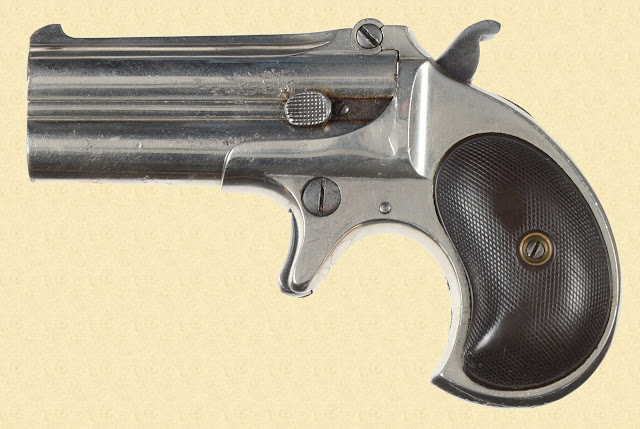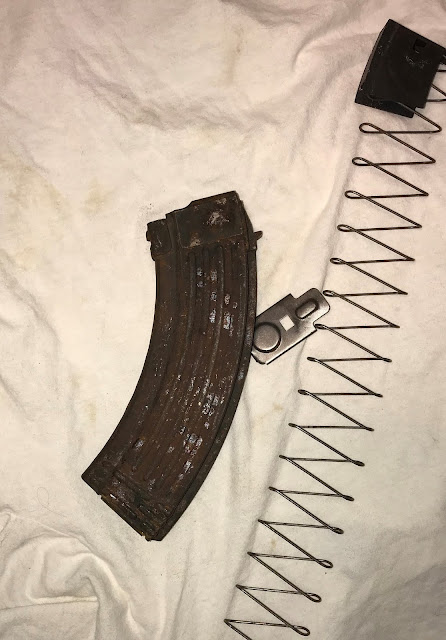Musket
We'll start with the term "musket". While the actual origin is debated, like many words in English, it comes from other Latin languages. The French word mousquette, was the name for a male Sparrow Hawk. Due to its suffix ette I assumed it meant "small mousqu", but mousquee in French is an Islamic Chruch....
The word was first applied to firearms in Europe circa 1499. The word went out of usage when smoothbore muskets were replaced by rifled muskets and eventually the word rifle took over.
Rifle
The word rifle comes from the series of grooves in a barrel designed to give the bullet a twist, which stabilizes its flight. The concept goes back to the archers of the 15th century who learned that giving a twist to the tail feathers of an arrow made it more accurate. When firearms and bullets came along, the concept was applied and was found to stabilize the flight of the bullet resulting in an increase in accuracy/precision as well as provide greater range.
The word for the practice of rifling a barrel probably came later, as it wasn't used to describe the process until the mid-1600s (150 years or so after rifled barrels first appeared). The word comes from the French word rifler which means to graze or scratch and has older usage in Old High German in the word riffilon and the Old Norse rifa both of which meant to tear, break or peel off.
Carbine
While the modern definition is a rifle with a barrel length of 20 inches or less, it wasn't always that way.
In the early days of long arms rifled muskets often had really long barrels, for instance the Springfield Rifled Musket model of 1861 had barrel of 40 inches, ridiculous by todays standards.
One of the first military guns to wear the moniker of "Carbine" was another German arm: the Karbiner 98a, which had a barrel length of 23.62 inches. As manufacturing, bullets and gun powder improved the need for a longer barrel waned. Somewhere along the way the line was drawn at 20". More than 20" of barrel = rifle, at or less than 20" = carbine.
The term originated with the French. It comes from the old French word carabin, which simply meant solider with a rifle. Some speculate that the word originated with the medieval Latin calabrinus, which referred to weapons made in the Italian town of Calabria. Another possibility is the word originated from the Greek word escarrabin which is the name for the Scarab Beetle, not sure where the connection is, but the word is similar.
Pistol
The word pistol first hit the English language around 1570, before that it was a French word pistolet. It is believed the word originated with the Czech. The Czech word for a pipe or whistle was pis'tala. When looked at from the side, the early pistols did look like an inverted whistle or pipe. The application of this word for a handheld firearm dates back to the 1420s.
Today it is used to describe a semi-automatic handgun, but in reality all handguns are pistols....even revolvers. The term is simply another word to describe a handgun.
Blunderbuss
The Blunderbuss was an early rendition of a shotgun. The barrel was short and heavily flared at the end to spread the pattern out, this limited its range, regulating it to defensive use.
The Blunderbuss was/is loaded from the muzzle and used more than just lead shot as the projectile. It was common for rocks, gravel, sand, bits of iron or anything else that was heavy and could inflict damage to be stuffed down the barrel.
The word comes from the Dutch, combining the word for thunder: donder and the word for pipe: bus....thus the Donderbus or Blunderbuss was a "Thunderpipe". As with many words the transition to English changed the spelling and pronunciation.
Dragoon
Long before the revolver came along, the term "Dragon" was used to describe a blunderbuss pistol. The Dragon was basically a handheld shotgun. Called a Dragon for the flames it belched from its short barrel and because many early examples were decorated to look like a dragon. It is possible the word came from the early Dutch or German word tragen or dragen respectively, the word(s) mean "to carry", which fits, as it was applied to horse mounted troops who carried pistols.
How the word Dragon became Dragoon is anyone's guess....
A Colt model of 1858 "Dragoon"
Magazine
The word breech comes from Old German, Old Norse or Old Dutch, originally meaning to break into two parts and referred to the lower half or the legs of a person (this is where we got the word britches from to describe pants). It also meant "break into" as in breaking down a door.
Stock
The word stock has many origins, Old Norse, German, Saxon, Dutch, in all of these languages the word stoc or stuk meant a tree trunk, stump, stick or piece of wood. It began being applied to guns in the 1500s.
Muzzle
This one is easy. A muzzle is another word for snout, used to describe an animals mouth and nose. When firearms came along it made sense to call the business end the muzzle.
Barrel
Of course we all know what the non-gun barrel is, but the word cask was also used for that description. The English version of the word probably came from the old French word baril, but similar words existed in old Spanish barril and old Italian barile, yet the word did not exist in Latin, so I did some more digging and found the Mongolian word for barrel is barryeli ni. It is possible the word was brought to the west by the Mongolian hoards. It was first applied to guns in the 1600s.
Trigger
The trigger, as if you didn't know, is the lever pulled to initiate the firing of the gun. The word originated with the Dutch word trekken which means "to pull", as with many words added to English it was changed to "trigger" along the way.
Hammer / Cock
I put these two together and they share the same origins.
The word cock comes from a variety of sources, the Greek kikkos, the Sanskrit kukkuta or the Malay kukuk. This suggests the word for the male fowl may have a much older, common ancestor.
The word was first applied to fire arms when the matchlock musket evolved into the flintlock.
The word hammer comes from the old Dutch, German and Norse word for stone, as the first hammers were made of stone.
Magnum
The name Derringer (also sometimes spelled with one r) comes from an actual gun maker Henry Deringer who introduced a short barreled percussion pistol in 1825. He marked the side of the lock with the word's "Philadelphia Deringer". I am not sure if that was the model name or if it was just letting people know by whom and where the gun was made. Nevertheless, the name began to be applied to other small single and even double barreled pistols.
This original Philadelphia Deringer was used to assassinate President Abraham Lincoln
A Remington model 95 "Derringer"
Lock
The word Lock could have several origins. There was an old German word lukana which meant to close, the old Norse lok which meant to fasten and the old Dutch luik which meant shutter or trap door.
Whatever the origin, it was applied to guns when the Wheellock and Flintlock rifles were invented. It refers to the plate upon which the cock, sear and spring were mounted.
Bayonet
The word Bayonet as you might expect comes from the French. The French spelling was baionnette, which probably means "little sword" and comes from the city of Bayonne, in Gascony (SW France) where the knives, designed to be attached to gun barrels, were first made in the early 1600s.
Bullpup
The definition of a "bullpup" is a rifle (or more often a carbine) with the action sitting behind the trigger (in the area normally occupied by the buttstock). The construction provides for a much shorter over-all length.
The origin of the name is believed to have come from the British military of the 1930s. The Limeys thought the abbreviated length of the rifles barrel reminded them of British Bulldog puppies.
The first British "bullpup" rifle the EM-2
Buntline Special
The commonly accepted definition of a "Buntline Special" is a revolver (most often single action) with a barrel length of 8" or more.
In the early days of revolvers The Colt revolvers with the longest barrels were the Calvary models (7.5" barrel). Anything longer was considered unique.
How the name "Buntline" came into use is quite a story. It goes back to the 1930s when a biographer names Stuart Lake decided to write the biography of Wyatt Earp (who died a year earlier). In the book Wyatt Earp: Frontier Marshal, he described the gun used by Wyatt in the famous Shootout at the OK Corral as being a Colt model of 1873 with a 12" barrel, he went on further to explain this gun was purchased by dime novel author Ned Buntline and given as gifts to several old west lawmen including Earp, but this was pure fiction.
There were two problems with that story. The first one is that Buntline never ordered or gave away any guns, the second is that Colt didn't offer a 12" barrel as standard model until the 1950s.
Historical records indicate that Wyatt did use a long barreled revolver at the shootout, but it was not a Colt and it was not given to him by Buntline. It was an 8" barreled S&W model 3 given to him by John Clum the then Mayor of Tombstone and owner of one of the towns newspapers. Apparently Lake heard about the gift of the long barreled revolver but not knowing what model or who gifted it he simply filled in the blanks. Hollywood took it as the gospel and every depiction of Earp on screen included a long barreled Colt SAA. So when Colt reintroduced the SAA in 1956, the catalog included a "Buntline Special". Read more about the story here.
The S&W model 3 with an 8" barrel, the original Buntline Special (perhaps we should rename this model the "Clum Special"?).
Kentucky Windage
In the early days of rifle shooting in America, the Kentucky rifle was king. The gun was a simple, accurate and dependable single shot, muzzle loading, black powder rifle. Although it originated in Pennsylvania, and was technically the American Long Rifle, it got the nick name Kentucky Rifle and it stuck.
The sights on these early rifles were either not adjustable at all or not easily adjustable for windage (side to side). This meant that a shooter attempting to hit a target when a cross wind was present would need to aim to the left or right of the target (whichever direction the wind was coming from) to compensate. This became known as "Kentucky Windage".
When most people hear the term "dope bag" they think of a sack containing illicit drugs, but to a rifle shooter it could mean something else entirely.
Since 1921 American Rifleman magazine has had a reoccurring section named "Dope Bag". According to most sources this term in shooting is actually an acronym D.O.P.E. which is Data Of (or On) Previous Engagement. Long distance shooters and sniper teams record this data on previous shots to assist with the adjustment of the telescopic sight, this is also referred to as "zeroing in", "doping your shot" or "doping the wind".
The "Dope bag" is the bag in which you keep ammo, tools or the booklet used to record the data.

























































